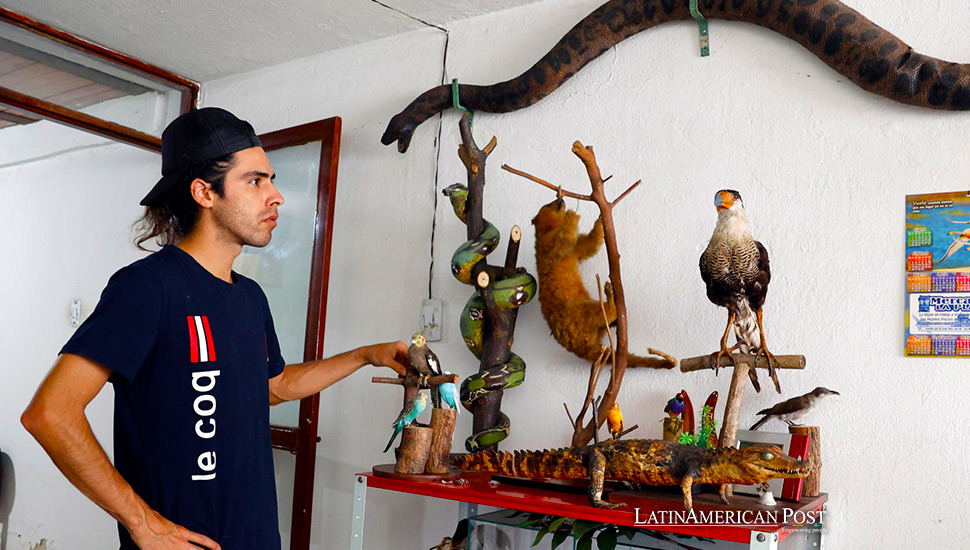The Business of Preserving Pets: Taxidermy Finds a Market in Colombia

In Bogotá, Miguel Vargas, a self-taught taxidermist, breathes life into the deceased, creating eternal memorials for cherished pets. His unique craft, deeply intertwined with Latin America’s historical and cultural fabric, faces modern challenges, reflecting a continent-wide struggle to balance tradition with evolving societal values.
Preserving Life Through Art: The Craft of Taxidermy in Bogotá
In the bustling metropolis of Bogotá, Colombia, Miguel Vargas stands as a solitary figure in the fading art of taxidermy. At 33, with a self-taught background complemented by a formal education in Biology from the Universidad Nacional de Colombia, Vargas has devoted his life to transforming death into a form of eternal art. His studio, a curious gallery adorned with an array of preserved animals, from domestic pets to exotic birds and even a miniature hammerhead shark, is a testament to his unique craft.
Vargas’s journey into the world of taxidermy began over a decade ago, sparked by a fascination with immortalizing animals’ essence. This interest blossomed during his university years, leading him to a path less traveled, where art meets science in the delicate dance of preservation.
The practice of taxidermy, with roots stretching back to the ancient Chinchorro culture of Chile, has evolved over millennia. In Colombia, it emerged prominently in the 1960s, transforming from a method of preserving large game and exotic species for display into a nuanced art form that captures the beloved details of family pets.
Taxidermy transcends its traditional boundaries in the heart of Vargas’s studio, offering grieving pet owners a chance to keep their cherished companions close. Vargas crafts these memorials with a reverence for life, encapsulating the joy and companionship these animals brought to their human counterparts.
Modern Challenges: Navigating a Changing Society
However, taxidermy faces modern challenges, reflecting broader shifts in cultural values and interests. In a society increasingly focused on the digital and ephemeral, taxidermy’s meticulous, hands-on art must maintain relevance. Vargas notes a decline in interest, with fewer people appreciating the skill and dedication required to preserve the beauty and dignity of these creatures.
Despite the growing disinterest, Vargas continues to innovate within his field. His work has gradually shifted from traditional taxidermy to a specialized focus on skeletal reconstruction. This niche within a niche allows him to engage with the anatomy of animals in a way that is both scientifically intriguing and artistically fulfilling.
Vargas’s skeletal displays, intricate and delicate, require a deep understanding of biology and an artist’s touch. They resonate with a specific demographic that appreciates these pieces’ blend of aesthetic beauty and educational value. Unlike the more time-consuming taxidermy, skeletal reconstruction provides a quicker yet equally captivating alternative.
The social perception of taxidermy in Colombia and Latin America at large is complex and often fraught with misconceptions. Linked historically to trophy hunting and colonial exhibitions, taxidermy grapples with a stigma that Vargas is determined to dispel. He emphasizes his work’s artistic and conservationist aspects, distancing it from the exploitative practices of the past.
Vargas has encountered apathy and misunderstanding in his efforts to educate and inspire a new generation. His attempts to conduct free workshops have met with limited success, reflecting a broader disinterest in traditional crafts and hands-on art forms in contemporary society.
The Future of Taxidermy in Colombia
Yet Vargas remains optimistic about the future of taxidermy in Colombia. He dreams of establishing a museum in collaboration with fellow University Nacional de Colombia alumni, focusing on the region’s rich avian diversity. This project, still in its conceptual phase, aims to create a space where the public can appreciate the beauty and complexity of taxidermy and the natural world.
The challenges Vargas faces in reviving interest in taxidermy indicate a more significant trend in Latin America, where rapid urbanization and technological advancement have led to a disconnection from traditional crafts and a loss of biodiversity. In this context, taxidermy can serve as a bridge between past and present, offering a tangible link to the natural heritage that is increasingly under threat.
In a broader sense, the decline of taxidermy in Latin America mirrors the region’s struggle to conserve its cultural and natural heritage in the face of modernization and environmental degradation. The art of taxidermy, with its deep roots in the continent’s history and its potential for conservation education, represents a vital yet underappreciated element of Latin American cultural identity.
As Vargas continues his solitary work in Bogotá, his studio stands as a beacon of resilience and passion for an art form that defies the march of time and technology. His commitment to taxidermy is not just about preserving the bodies of animals but also about maintaining a connection to the rich tapestry of life and death, history, and culture that defines Latin America.
Miguel Vargas’s endeavors in the realm of taxidermy offer a window into the complex interplay between tradition and modernity in Latin America. His work challenges us to reconsider the value of preserving the physical forms of our natural world and the artisanal skills and cultural legacies that connect us to our past. In a rapidly changing world, the art of taxidermy stands as a poignant reminder of the fragility of life and the enduring power of memory, offering a unique perspective on the importance of conserving our biological and cultural heritage.
Through Vargas’s meticulous eyes, taxidermy transcends conventional perception, evolving into a medium that captures the enduring spirit of nature and the essence of Latin American cultural richness. His studio, a sanctuary of preserved life, embodies the silent stories of the region’s diverse fauna, echoing the broader narrative of Latin America’s historical journey and its ongoing battle against the tides of time and modernity.
A Testament to Heritage: Vargas’s Legacy in Latin America
As Vargas meticulously stitches the seams of the past to the present, his work serves as a testament to the enduring legacy of Latin America’s natural and cultural heritage. In the face of contemporary challenges, his dedication to taxidermy not only preserves the physical remnants of life but also ignites a conversation about the significance of remembering and respecting our shared history and the natural world.
In a time when the rapid pace of change threatens to erase the traces of the past, the art of taxidermy, as practiced by Vargas, offers a poignant reflection on the need for conservation, memory, and education. It stands as a reminder of the delicate balance between life and death, the past and the future, and the interwoven fabric of nature and culture that defines the essence of Latin America.
By delving into the world of taxidermy, Vargas and like-minded artisans across Latin America are not merely preserving the remains of creatures that once roamed the earth; they are safeguarding the stories and lessons embedded in every feather, fur, and bone. These preserved beings, though no longer breathing, continue to speak volumes about the intricate dance of ecosystems, the bonds between humans and animals, and the rich tapestry of life that constitutes the heritage of Latin America.
Also read: Colombia’s Oil Dilemma: Curbing Illicit Fuel and Organized Crime
In the final analysis, the challenge and beauty of taxidermy lie in its power to make the transient permanent, to hold onto the fleeting moments of life, and to offer future generations a glimpse into the world that once was. In the hands of artists like Miguel Vargas, taxidermy becomes an act of reverence and remembrance, a defiant stand against the forgetting of the natural and cultural realms that have shaped the identity of Latin America. Through his work, Vargas not only gives animals a second life but also breathes new life into the enduring legacy of Latin American heritage, ensuring that its rich biodiversity and cultural narratives continue to inspire and educate long into the future.




